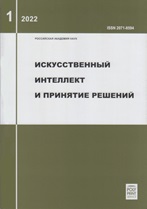|
This article is cited in 1 scientific paper (total in 1 paper)
Computational intelligence
Joint use neural networks and evidence theory methods in control and diagnostic fuzzy systems
V. K. Ivanov, B. V. Paliukh
Tver State Technical University, Tver, Russia
Abstract:
The article describes the study results of various intelligent data processing methods, such as neural networks and algorithms of the theory of evidence, joint use. The study was conducted on the development of diagnostic systems examples. These methods hybridization is one of the general approaches to reduce uncertainty in the data used and increase the degree of confidence in them. The data uncertainty is of an objective nature when they are obtained from the sensors of technological equipment, from technical regulations, as well as from expert specialists. The study includes an analysis of modern developments descriptions presented at significant international conferences and
published recently. Several dozen descriptions of the systems composition, structure and main algorithms functioning developed for projects in various fields were reviewed. As a result, the joint application modes of neural networks and theory of evidence algorithms including the features of architectures and their implementation are determined. We also summarized information about the effectiveness of these methods’ joint application in terms of the uncertainty level reducing and confidence level increasing in the decision-making data. The scope of this study results application is the architectural solutions design of a hybrid expert system for diagnosing the technology processes state and detecting anomalies in them.
Keywords:
neural network, Dempster-Schafer evidence theory, hybrid expert system, diagnostics, manufacturing process, fuzzy system, network training, belief function.
Citation:
V. K. Ivanov, B. V. Paliukh, “Joint use neural networks and evidence theory methods in control and diagnostic fuzzy systems”, Artificial Intelligence and Decision Making, 2021, no. 4, 75–88; Scientific and Technical Information Processing, 49:6 (2022), 446–454
Linking options:
https://www.mathnet.ru/eng/iipr120 https://www.mathnet.ru/eng/iipr/y2021/i4/p75
|

| Statistics & downloads: |
| Abstract page: | 24 | | Full-text PDF : | 9 | | References: | 1 |
|




 Contact us:
Contact us: Terms of Use
Terms of Use
 Registration to the website
Registration to the website Logotypes
Logotypes








 Citation in format
Citation in format 
